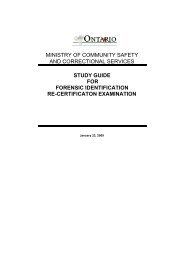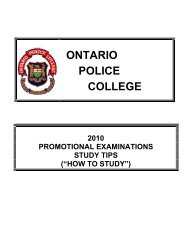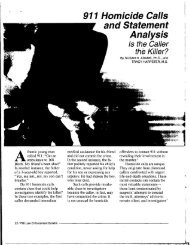General Study Guide - Ontario Police College
General Study Guide - Ontario Police College
General Study Guide - Ontario Police College
Create successful ePaper yourself
Turn your PDF publications into a flip-book with our unique Google optimized e-Paper software.
Leucomalachite Green (RCMP)<br />
extremely sensitive to the presence of blood and will yield positive<br />
results with dilutions of blood as low as 1 part in 1 million.<br />
Green<br />
Leucomalachite green reacts with the protein in<br />
blood to produce a green color.<br />
Cyanoacrylate fuming – non-porous substrates<br />
Prior to fuming, the moisture in the latent print residue may be regenerated<br />
by exposure to acetic vapours, thus improving quality.<br />
Research has shown that applying CA before using a general protein<br />
stain achieved no improvement in the enhancement of bloody prints.<br />
With glass and metal surfaces, CA is harmful for further processing with<br />
Coomassie Blue, Crowle’s reagent, and amido black dye.<br />
White<br />
Fumes from the active cyanoacrylate ester<br />
polymerizes components of the print residue.<br />
Post-cyano dye stains &/or regular or magnetic<br />
powders are used to further enhance the<br />
developed prints. Refer to separate table for a list<br />
of possible dye stains and appropriate forensic<br />
light sources.<br />
Titanium Dioxide (OPC Notes)<br />
6 or 7 spray applications with continuous agitation of mixture in bottle.<br />
Leave for 30 seconds.<br />
Methanol rinse applied in same manner as working solution.<br />
Allow to air dry.<br />
White<br />
For developing bloody prints on dark surfaces.<br />
Acid Yellow (OPC Notes) Yellow View when dry using alternate light source at<br />
450nm and orange goggles.<br />
Luminol (OPC & RCMP Notes)<br />
An alkaline solution of Luminol will oxidize in the presence of an<br />
oxidizing agent such as hydrogen peroxide or sodium perborate and a<br />
Hematin-catalyzed peroxidase system, such as that found in blood.<br />
This oxidation<br />
reaction produces a<br />
blue<br />
chemiluminescence.<br />
1. Darken crime scene.<br />
2. Set-up camera for photography.<br />
3. Wearing face shield and officer protection<br />
suits spray area with luminol solution.<br />
4. Immediately photograph<br />
chemiluminescence.<br />
Repeat spraying step if chemiluminescence<br />
fades. Note - False positive reactions are<br />
common.

















